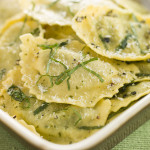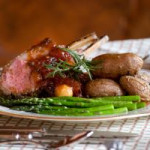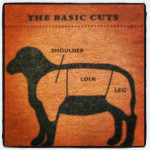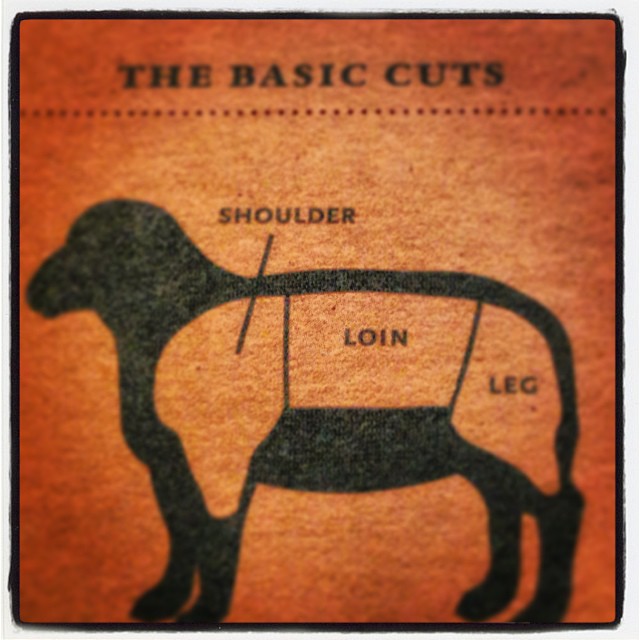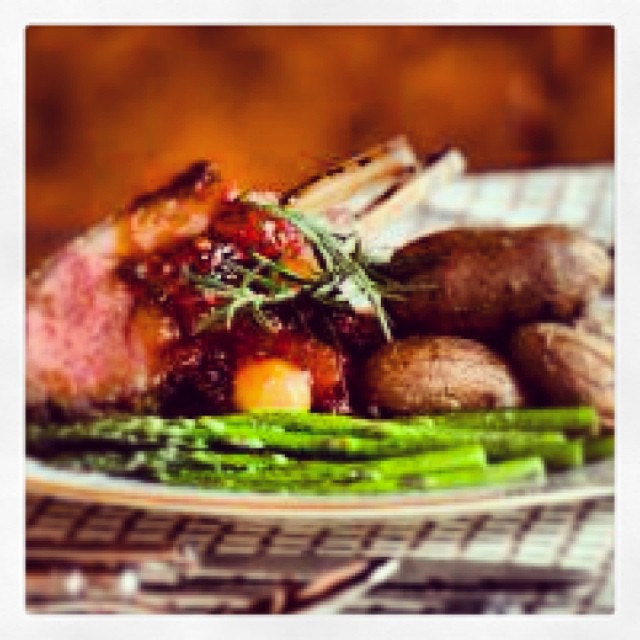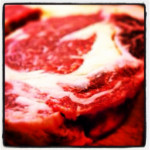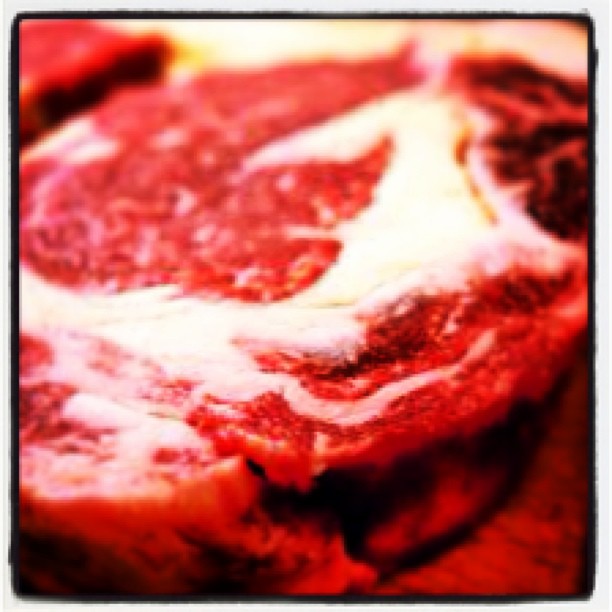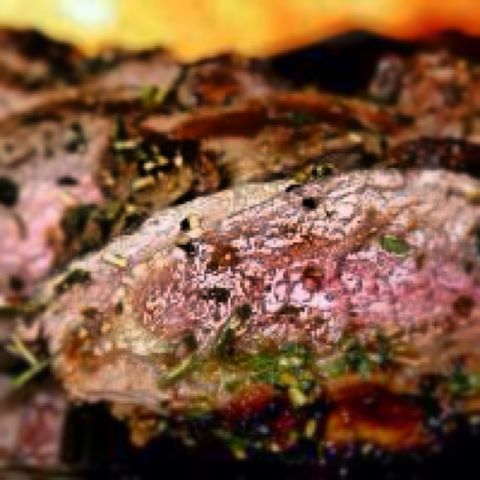Cooking With Lemons
Lemons are a chef’s secret ingredient. Most chefs will tell you that acidity elevates any dish. There is no need to get all fancy by using twenty year old balsamic vinegar. Just finish most of your dishes with a humble squeeze of lemon juice. Most line cooks have quart containers of wedges at their stations for juicing in the moment. Why lemon? Aside from the fact that you can always find one, you’ll taste what it does to the food, not the lemon itself. Along with salt and pepper, it’s all you need to season everything from simple pastas to grilled fish, roasted meats, and sautéed vegetables, as well as pan sauces, grain salads, and even run of the mill lentil soup. In your own kitchen cut lemon wedges ahead of time, then squeeze as you cook for the brightest flavor.
“Work With What You Got!”
© Victoria Hart Glavin Tiny New York Kitchen © 2016 All Rights Reserved
Watermelon
Watermelon is the ultimate summer snack. As a kid growing up in Nebraska, my favorite way to eat watermelon was outside, with the juice running down my face and arms. Here is how I’m eating watermelon this summer.
Treat It Like A Steak
Cut watermelon into 2 inch slabs and drizzle with olive oil. Sprinkle with kosher salt and red pepper flakes. Eat with a steak knife.
Make A BLW
Forget the tomato and use a few thin slices of watermelon on your sandwich instead. Add some cheese for good measure.
Blitz It
Purée watermelon (seeds and all), strain, then add honey, and lime juice. Serve on ice with a mint sprig. Add rum or tequila if you want to be naughty.
“Work With What You Got!”
© Victoria Hart Glavin Tiny New York Kitchen © 2015 All Rights Reserved
Spring Ravioli
Capture springtime on the plate with fresh ravioli enveloping a purée of sweet English peas that is bolstered with a touch of cheese and herbs. Simmer these ravioli for just a few minutes, drain (but not too thoroughly) and add a couple of tablespoons of butter to the pan. Once the butter melts, return the ravioli to the pan, add a bright toss of lemon zest and season with salt and pepper. Some grated Parmesan and slivers of fresh mint or a handful of pea shoots are worthy embellishments.
“Work With What You Got!”
© Victoria Hart Glavin Tiny New York Kitchen All Rights Reserved
Roasted Leg of Lamb Roman Style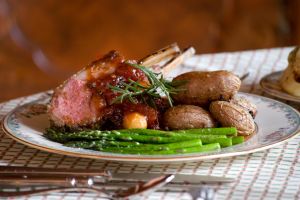
This is such an easy Sunday meal. For this traditional Roman dinner, purchase 1/4 of a nice fat “abbacchio”. In Rome “abbacchio” is a very young lamb, which has been fed only with milk. I usually purchase my “abbacchio” from a nice butcher in the Arthur Avenue area of the Bronx. If you don’t want to buy 1/4 of a young lamb then just get a decent sized leg of lamb that will accommodate the size of your family (make sure it’s not been previously frozen). Insert cloves of garlic, both lean and fatty ham, chopped stalks of rosemary, kosher salt, freshly ground pepper, and brush all over with olive oil. Salt again and roast in a medium hot oven (350 degrees) for 1 hour together with lots of raw potatoes either whole (small potatoes) or cut into pieces (larger potatoes). After about half an hour, add 1 glass of dry white wine and turn the lamb over and cook the other side for another half an hour. When the lamb is done roasting, cut into pieces and serve with the potatoes, steamed asparagus and a nice chicory salad.
Note: By the way, if you’ve never been to Arthur Avenue in the Bronx then you’re really missing quite an experience. Forget Little Italy downtown because Arthur Avenue is the real deal although tourists have discovered it as well. A great time to go is during the Christmas season. Often times they have Frank Sinatra piped Christmas songs blaring from loud speakers posted high up on the lampposts. My Arthur Avenue butcher is a total crackup. He’s in a great mood during the Christmas season because according to him it’s the one time of the year that his wife is “nice” to him if you know what I mean and he’s not shy to chirp about it either. My husband is Italian and looks it so much that they say the map of southern Italy is stamped on his face. One time I needed to pick up a few things on a Saturday during the holidays and it was so busy that there was no parking to be found. My husband found a spot, but the meter was broken. There was a “group” of Italian men donned in the “I can’t fit in my clothes” velour track suits (adorned with gold chains carrying either St. Christopher or the Virgin Mary herself) hanging around by the broken metered parking spot. My husband was inspecting the broken meter worrying about a parking ticket when the guys pipe up, “Heeeey don’t worry bout it. We’ll watch to make sure you don’t get a ticket. We’ll take care of it.” Sure enough we get back to the car after about an hour and no ticket even though we could see the NYC parking police patrolling the streets. My husband said a sincere, “thank you” to which he received a sincere “don’t mention it” and we were on our way.
Lamb Cooked 3 Ways
Cooked low and slow, lamb shanks become rich with complex flavors. Lamb shoulder is also a great choice for slow cooking. Good value cuts are: Shoulder Chops, Stew Meat, Ground Lamb, and Leg Steak.
The USDA recommends cooking all whole muscle cuts of lamb to at least these temperatures to ensure that potentially harmful bacteria are destroyed. Some people may choose to cook their meat to lower temperatures, depending on preference. Ground lamb should be cooked to 160 degrees.
Desired Doneness:
Medium – Target Temperature 145 Degrees, Texture Warm/Firm, Center Color Pink
Medium Well – Target Temperature 155 Degrees, Texture Very Warm/Firm, Center Color Gray – Tinged With Pink
Well Done – Target Temperature 165 Degrees, Texture Hot/Dense/Hard, Center Color Gray
Best Cooking Methods For Lamb
Shoulder Blade Chops (Shoulder): Braise, Broil, Grill, Roast, Pan-Fry, And Stew
Rib Chops (Loin): Broil, Grill, Roast, Pan-Fry, And Sauté
Loin Chops (Loin): Broil, Grill, Roast, Pan-Fry, And Sauté
Whole Leg (Leg): Braise
Leg – Boned, Rolled, Tied (Leg): Grill, And Roast
Rack of Lamb (Loin): Broil, Grill, And Roast
Crown Roast (Loin): Roast
Top Round Roast (Leg): Braise, Roast, And Stew
Stew Meat (Various): Braise, And Stew
Sausages (Various): Braise, Grill, Roast, Pan-Fry, And Sauté
Shanks (Leg): Braise, And Stew
Lamb Chops 2 Ways
Classic Broiled: Preheat broiler. Arrange chops on broiler pan and season with kosher salt and pepper. Broil 4 to 5 minutes per side, or until target temperature. Remove pan from broiler, cover with foil and allow chops to rest 10 minutes before serving.
Rosemary Garlic: Puree 6 garlic cloves with 2 Tablespoons fresh rosemary. Add 1/2 cup olive oil, kosher salt and pepper. Marinate chops 30 minutes or overnight. Grill over medium-high heat, or broil according to above directions.
Roast Leg of Lamb With Mint Jelly: Preheat oven to 450 degrees. Combine 2 Tablespoons kosher salt, 1 Tablespoon black pepper, 1 Tablespoon finely chopped fresh rosemary and 1/3 cup olive oil. Rub mixture all over roast. Make a few dozen small slits in lamb and insert garlic slivers. Place lamb in roasting pan and roast 10 minutes, reduce temperature to 325 degrees and roast until target temperature, about 1 1/2 hours. Cover with foil and let rest 15 minutes. Serve with mint jelly.
Roast Beef Tenderloin 3 Ways
Here are three different ways to cook Beef Tenderloin. Remember to let your roast rest for a bit after removing from the oven because it will continue to cook.
Classic
1 Two to Six Pound Beef Tenderloin
4 Tablespoons Olive Oil
1 Tablespoon Minced Garlic
3 Tablespoons Rosemary
2 Tablespoons Thyme
2 Tablespoons Kosher Salt
2 Tablespoons Freshly Ground Pepper
Preheat your oven to 350° F. With 2 tablespoons olive oil lightly oil a roasting pan. Position the oven rack on center rack. In a small-size bowl combine 2 tablespoons of olive oil, garlic, rosemary, thyme, kosher salt, and pepper. Rub the spice mixture over the entire surface of tenderloin. Place into roasting pan and place into oven. Cook for about 35 to 55 minutes depending on target temperature. Remove from oven and let rest 15 minutes before serving. Serves 2 to 6 depending on size of tenderloin.
Smoked Paprika
1 Two to Six Pound Beef Tenderloin
5 Tablespoons Olive Oil
3 Tablespoons Smoked Paprika
1 Teaspoon Oregano
Zest of 1 Lemon
Juice of 1 Lemon
1 Teaspoon Kosher Salt
1 Teaspoon Freshly Ground Pepper
Preheat your oven to 350° F. With 2 tablespoons olive oil lightly oil a roasting pan. Position the oven rack on center rack. In a small-size bowl combine 3 tablespoons of olive oil, smoked paprika, oregano, zest & juice of lemon, kosher salt, and pepper. Rub the spice mixture over the entire surface of tenderloin. Place into roasting pan and place into oven. Cook for about 35 to 55 minutes depending on target temperature. Remove from oven and let rest 15 minutes before serving. Serves 2 to 6 depending on size of tenderloin.
Cajun Style
1 Two to Six Pound Beef Tenderloin
2 Tablespoons Olive Oil
3 Tablespoons Cajun Seasoning
1/2 Teaspoon Cayenne Pepper
1 Teaspoon Kosher Salt
1 Teaspoon Freshly Ground Pepper
Preheat your oven to 350° F. With 2 tablespoons olive oil lightly oil a roasting pan. Position the oven rack on center rack. In a small-size bowl combine Cajun seasoning, cayenne pepper, kosher salt, and pepper. Rub the spice mixture over the entire surface of tenderloin. Place into roasting pan and place into oven. Cook for about 35 to 55 minutes depending on target temperature. Remove from oven and let rest 15 minutes before serving. Serves 2 to 6 depending on size of tenderloin.
Here are some super easy, but versatile Pasta Salad Ideas from Tiny New York Kitchen. All you need to do is add 3 cups of cooked & chilled pasta (of your choice) and 1 tablespoon of extra virgin olive oil to one of these inspiring combinations. Try them all throughout the summer for a whole treasure trove of side salads. If you want to make any of these a main dish then add 1 pound of protein such as grilled chicken breasts, grilled flank steak, grilled shrimp, grilled tuna (or canned tuna) or tofu. All recipes below serve 4.
For the Pasta: Cook 3 Cups of Pasta, Toss With 1 Tablespoon Extra Virgin Olive Oil & Then Chill Until Ready To Use. Add the Pasta to One of the Salad Combinations Below.
Nutty Beans & Greens
1 Cup Trimmed & Steamed Haricot Verts
1 Cup Baby Arugula
3 Tablespoons Toasted & Chopped Walnuts
1 Ounce Shaved Parmigiano-Reggiano Cheese
Snow Peas & Carrots
1/2 Cup Grated Carrot
1 Tablespoon Soy Sauce
1/2 Cup Thinly Sliced Snow Peas
1/2 Cup Shredded Red Cabbage
1/4 Cup Dry Roasted Peanuts
Cheesy Chickpea & Pesto
1/2 Cup Cooked Chickpeas
1 1/2 Ounces Crumbled Feta Cheese
1 Cup Halved Grape Tomatoes
1 Tablespoon Prepared Pesto
Mediterranean Medley
1/3 Cup Chopped Fresh Basil
1/2 Cup Thinly Sliced Cucumber
1 Cup Halved Cherry Tomatoes
1 1/2 Ounces Crumbled Feta Cheese
1 1/2 Ounces Sliced Kalamata Olives
Peppery & Nutty
1 Cup Arugula
2/3 Cup Thinly Sliced Radishes
3 Tablespoons Toasted & Chopped Walnuts
2 Ounces Crumbled Goat Cheese
Melon, Mint & Parm
1/2 Cup Fresh Cubed Cantaloupe
2 Tablespoons Fresh Mint Leaves
2 Ounces Thinly Sliced Prosciutto
1 1/2 Ounces Shaved Parmigiano-Reggiano Cheese
Freshly Ground Pepper
Cherry Almond Crunch
3/4 Cup Pitted Halved Fresh Cherries
1/4 Cup Toasted & Thinly Sliced Almonds
2 Tablespoons Chopped Fresh Basil
1 1/2 Ounces Crumbled Goat Cheese
Picnic Superstar
1/3 Cup Sliced Avocado
1/4 Cup Red Bell Pepper Strips
1/4 Cup Fresh Corn Kernels
2 Cooked Crumbled Center Cut Bacon Slices
2 Ounces Quartered Fresh Baby Mozzarella Balls
I love radishes and am always drawn to the pretty color of a pile of radishes. Most of us just slice them into a green salad and the left-over radishes die a fateful death in the fridge. Here are some non-salad ideas that will expand your radish repertoire.
Radish Sauté – It doesn’t really occur to many people that you can cook radishes (as with cucumbers). It’s so simple to sauté radishes in olive oil or butter. They are delicious and make you appreciate radishes in a while new way.
Kimchi – Sprinkle the radishes with a bit of kosher salt and a little chili paste. Toss together and then pack them into a glass jar. Place in the back of the fridge for two weeks. Excellent on top of a burger.
Butter & Sea Salt – A fine butter and a pinch of sea salt on top of a radish slice make the perfect summer bite.
Radish “Sauerkraut” – Slice 1 pound of radishes and toss with 1 tablespoon of kosher salt. Pack tightly into a glass jar. Weigh down with a wrapped can and place on a shelf for two weeks. Makes a great addition to a sandwich.
Shaved & Lightly Poached In A Tasty Liquid – Slivers of radish dropped in a simmering stock and/or wine for 10 seconds are a great compliment to fresh fish. They let go of their bite, but retain some of their unique crunch we all know and love.
Braised – Sauté a little onion and garlic. Add in some radish quarters and a healthy splash of red wine. Cover and simmer for 20 minutes. Finish with a squeeze of lemon or dash of vinegar. Excellent draped over a grilled steak or pork chop.
Pickled – Slice some 1/4 inch coins and throw them into a jar. Pour brine over them (1 teaspoon kosher salt, 1/2 teaspoon sugar, 1/2 cup water and 1 1/2 cups cider vinegar). You may want to throw in a few dried chilis if you want a bit of spice. Let sit in your fridge for a week.
Soup – Simmered for 30 minutes in a soup. The radishes will take on a sweet and velvety character.
Grated – Grate the radishes along with some freshly grated ginger and use as a condiment with any oily fish such as trout or mackerel.
Roasted – Quarter and toss with a little olive oil. Season with kosher salt and freshly ground pepper. Roast in an oven at 425º F for 20 minutes. They should be a little brown and will become sweet. Toss them with some toasted nuts. They are a great side dish at any potluck picnic.



